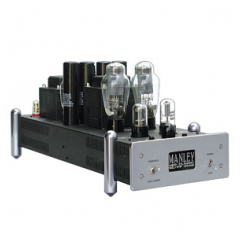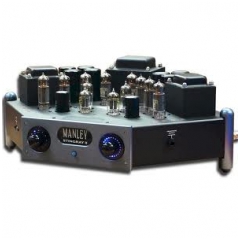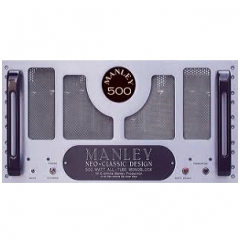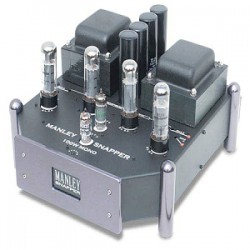Danh mục tin
THE STINGRAY iTube® STEREO INTEGRATED AMPLIFIER with iPod dock
FRESH FROM MANLEY LABS
 The famous Manley Stingray stereo integrated amplifier has been renewed and refreshed. New for 2009 we present to you the Stingray iTube integrated tube amplifier with iPod dock and full featured RF and IR remote control.
The famous Manley Stingray stereo integrated amplifier has been renewed and refreshed. New for 2009 we present to you the Stingray iTube integrated tube amplifier with iPod dock and full featured RF and IR remote control.
The STINGRAY iTube is the next evolution from our acclaimed Stingray Integrated Amplifier, legendary in the hifi world since it swam from our labs in 1997. Originally conceived with particular attention paid to optimal component placement for the purity and symmetry of the signal path layout, the Stingray quickly became one of our best-selling products. The Stingray iTube retains the same basic tube circuitry and marvelous output transformers as the original with some important improvements:
An iPod dock has been integrated into the Stingray iTube as the 4th input source. The Manley iTube has been certified by Apple and officially sanctioned as a "Made for iPod" product. The Stingray's Remote Control commands the iPod PLAY/PAUSE and TRACK FORWARD/BACK controls.
The iPod's video output is available at the S-Video output jack located on the left side facia.
The high voltage tube energy storage has been increased vastly resulting in even more solid and coherent bass control and impact.
A headphone jack has been added to the right side facia. This jack re-routes the output from the speaker binding posts and mutes the Subwoofer output feed.
The Remote Control works with both Radio Frequency and InfraRed technologies. Using the remote in RF mode gives freedom from having to "point and shoot." The RF remote is omnidirectional and works through walls and cabinets. IR capability is included for those with Universal Learning Remote Controls for consolidated integration into existing systems. The volume control, balance adjust, input switching, and iPod interface commands are all on the RF/IR Remote Control. Additionally user can perform the MUTE, DIM, INSERT and STANDBY commands with the Remote Control.
Each INPUT can be individually level trimmed to match and to optimize system gain staging of various input devices.
The fancy blue LED displays surrounding the INPUT and VOLUME encoder knobs can be dimmed down or turned off entirely, after a user-settable time period, or a "screen-saver" random light sequence can be selected. Speed and intensity of the "Starlight" mode can be tweaked to taste.
All custom user settings are hard written into memory when the unit is put into STANDBY mode and thus retained if power is later interrupted.
Individual sealed gold contact relays deliver the selected input into the volume control system before hitting the first 12AT7 input tubes. Following the mighty 6414 driver/phase splitter, the trusty EL84 output stage can be switched between either 20 watts of TRIODE power or 40 watts of Ultra Linear mode push-pull operation. Individual bias for each tube is easily adjusted using the trimpots and test points, conveniently located on the top surface of the amplifier. The Stingray's power supply is extra-rugged and stiff, a MANLEY hallmark. It swims with the sharks: fast, agile, fluid, and with consummate authority.
Post-volume SUBWOOFER OUTPUT allows easy hookup of outboard line-level driven active powered subwoofers. This output is after the volume control so that the subwoofer will track the volume level changes of the main speakers. The SUB OUTPUT is a line level and full frequency output that is AFTER the volume control so your powered subwoofer follows the same volume as your main speakers. These are unbalanced RCA jacks, line level. They feed the line inputs of your subwoofer, NOT the speaker jacks. A switchable TAPE LOOP is standard. The TAPE SEND is the output of the selected input before the volume control. The TAPE RETURN can also be used as a 5th line input if needed.
RECORD OUT (aka Tape OUT) is BEFORE the volume control so you can record whatever input you have selected without your listening level affecting the level going to your recorder. These are unbalanced RCA's. It is UNbalanced RCA's and UNbuffered so check out the input Z to your recorder to make sure it won't load down the Stingray main input while it is plugged in. Usually with unbuffered record outs we recommend you only plug in your recorder only when you are actually recording...
Tape LOOP: Also known as an INSERT point, the SEND or Tape Out comes off the selector switch as the Record Out option does going to your outboard EQ or Merlin BAM unit or tape recorder and then the signal returns (RETURN) to the Stingray in front of of the volume control so you can play tunes. A toggle switch selects whether the Tape LOOP (and whatever is plugged into the Tape Loop) is active or the signal goes straight through the Stingray as normal. If you have the Merlin BAMsystem, order your Stingray with the Tape LOOP option.
Need more than four inputs? Get a SKIPJACKline switcher and run it into this LOOP RETURN: The SKIPJACK is perfect for adding more inputs to anything. So if you use a SKIPJACK's 4 stereo inputs plus the Stingray's 4 stereo inputs you'll get 8 stereo inputs total. The way to do that is to consider the TAPE LOOP: you can bring the SKIPJACK output into the LOOP RETURN, enact the LOOP ACTIVE switch and use the 4 x SKIPJACK inputs feeding the LOOP RETURN with the SKIPJACK controlling source switching for those 4 inputs. Then if you put the Stingray's LOOP switch to BYPASS you will be working with the 4 x Stingray inputs selectable on the Stingray. That gives you 8 total stereo inputs as shown below.

Or if you do not want to use the TAPE LOOP feature (because you are using it for other purposes) or if you have an older Stingray without the TAPE LOOP, you can use a SKIPJACK to get up to 7 stereo line inputs by running the SKIPJACK's output into one of the Stingray's inputs as shown below:

NOTE: The SUBWOOFER OUT, RECORD OUT, and TAPE LOOP are all passive. So are the BALANCE and VOLUME controls also passive. No active electronics or buffers are used in these circuits. The RECORD OUT comes straight off the input select switch. So whatever source is selected will show up passed through at the TAPE OUT.
iPod Compatibility:
iPod can play songs with the these sample rates, and with all compatible codecs
- 8 kHz
- 11.025 kHz
- 16 kHz
- 22.050 kHz
- 32 kHz
- 44.1 kHz
Here is a list of compatible codecs
The iPod will play up to 16 bit/48Khz files.
Read John Atkinson's iPod measurements from the Stereophile review of an iPod
"The iPod's measured behavior is better than many CD players-ironic,
considering that most of the time it will be used to play MP3 and AAC files,
which will not immediately benefit from such good performance. But if you're
willing to trade off maximum playing time against the ability to play
uncompressed AIFF or WAV files, the iPod will do an excellent job of
decoding them. Excellent, cost-effective audio engineering from an
unexpected source."
iTunes Compatibility:
iTunes is not compatible with FLAC format files without a third party
plugin.
iTunes does support 24/96 wav files. iPod won't play them, but iTunes does
support them.
iTunes can in fact output 24/96 digitally, so in theory you could actually
assemble a hi-rez music server based on iTunes, and use it to drive the DAC
of your choice.
Thus using your iPod docked on your Stingray iTube you can play WAV files which will yield similar audio quality to CD.
With the Stingray, the MANLEY team has struck a remarkably harmonious balance in design which satisfies the sonic desires of the audiophile and the rocker, the artist and the musician, the student and the master, the yin and the yang. We invite you to experience the stunning sonic quality and visual beauty of the Stingray personally.
Get the owner's manual for the Manley Snapper iTube®
Features and Specifications
MANLEY STINGRAY iTube®
- 3 x Stereo Line RCA Inputs
- 1 x iPod dock (analog output used)
- TRIODE - UL Output Stage Mode Switching
- RECORDING OUT
- SUBWOOFER OUT
- TAPE LOOP (Insert) with Bypass switch
- S-VIDEO OUT (from iPod dock)
- 1/4" Headphone OUTPUT (mutes speakers and subwoofer output when deployed)
- Logic controlled Volume and Balance functions
- All-Vacuum Tube Lo-feedback Stereo Integrated Design
- Output Tubes: 8 x EL84 Ships with Russian NOS EL84M (aka 6Pi14Pi-EB)
- Driver Tubes: 2 x 6414 Ships with GE or RAYTHEON JAN NOS USA or 6414W
- Input Tubes: 2 x 12AT7EH Ships with: 12AT7EH large plate Electro-Harmonix Russian
*** USING OTHER TUBES: Read FAQ #16! ***
- Maximum Output Power UL mode: 32 Watts x 2 channels 1.5% THD @ 1kHz into 5 Ohms
- Maximum Output Power TRIODE mode: 18 Watts x 2 channels 1.5% THD @ 1kHz into 5 Ohms
- Frequency Response: 15 Hz - 58 kHz, -1dB
- Gain: 35 dB at max Volume
- Input Sensitivity UL Full Power: 210 mV in = 32 watts out into 5 Ohms with volume control at maximum
- Input Sensitivity Triode: 41mV in = 1W into 5 Ohms with volume control at 20dB gain setting
- Input Sensitivity UL: 35mV in = 1W into 5 Ohms with volume control at 20dB gain setting
- Crosstalk: -72dB See Chart
- Noise: 5.8 microVolts A-WGT; @600 Ohms
- S/N Ratio: typically 97 dB A-WGT @ 600 Ohms
- S/N Ratio: typically 72 dB A-WGT, 1W output, 20dB gain, Source Z = shorted input
- THD+N Ratio: typically 64 dbat 1W output, Bandwidth 22Hz-22Khz, Source = 1Khz Sine wave
- Input Impedance: 12 kOhm nominal
- Output Impedance at TAPE Output: 47 Ohms
- Optimum Speaker Load: 5 Ohms
- Speaker Terminal Output Impedance at 20 Hz: 2.36 Ohms
at 1KHz: 2.00 Ohms
at 20KHz: 1.83 Ohms - Damping Factor into 8 Ohms (UL mode): 6.7 @ 100 Hz; 7.2 @ 1 kHz; 6.9 @ 10 kHz
- Damping Factor into 8 Ohms (Triode mode): 7.2 @ 100 Hz; 7.8 @ 1 kHz; 8.0 @ 10 kHz
- Headphone Jack Output Impedance: 53 Ohms
- Scratch Factor: Use pennies under pointed feet to avoid marring cabinetry. Try quarters if you are in upper tax brackets. The bargain performer would be nickels. Paper currency does not function as well. Euro coins work 1.54 times better.
- Remote Control Type: RF (radio frequency) and IR (infrared), user selectable
- Volume Control: Cirrus Digital Level Control System, controlled by Grayhill Rotary Encoders
- Volume Control Range: 102dB in 1dB steps turning slowly, with larger steps as rate of turn increases
-
Power Consumption (Standby, no iPod charging): 6W
- Power Consumption (Standby, iPod charging: 12W
- Power Consumption Idle: 198W
- Maximum Power Consumption at Full Power: 300W
- MAINS Fuses:
100~120VAC operation: MDL 3 AMP / 250 Volt SLO-BLO
220~240VAC operation: MDL 1.5 AMP / 250 Volt SLO-BLO -
B+ FUSES (2): MDA 1/4 AMP, 250 Volt SLO-BLO, Ceramic.
- Power Supply: is factory set for 100V, 120V or 220-240VAC operation
for original destination country's mains voltage. - Operating Mains Voltage: changeable with power transformer re-wiring on PCB and fuse value change.
- Mains Voltage Frequency:
- Power Cord: Detachable IEC standard.
Appropriate power cord supplied for original destination country - Dimensions: W= 19", D=14", H= 7 1/2"
- Shipping Weight: 35 lbs.
Specifications subject to change because they just might.
Manufacturer's Suggested Retail Price
- Manley Stingray iTube® $6,000 (USD $)
- Manley Stingray II $5,650 (USD $)
What are the differences between the Stingray iTube and the Stingray II?Mainly: the Stingray II has 1/8" line input instead of iPod dock.The Stingray II has four sets of stereo analog inputs. The 4th input is on a stereo 1/8" jack for easy interface with portable devices and computers. The Stingray iTube® has an iPod dock as the 4th audio input which will charge and play your iPod, iPhone, or iTouch device. Track advance, back and volume control can be commanded from the Stingray iTube's remote control. The iPod's video output can be ported to a monitor via the S-Video output. The Stingray iTube® has been licensed from Apple as a Made for iPod approved device.Note: the original Stingray has been discontinued.
NOT AVAILABLE OPTIONS!
Balanced inputs are not available. It's a single-ended input topology and so to balance it we would have to add chips or transformers. There is no power supply for IC's available inside and no room to fit more transformers or XLR's so please take the RCA's with a kind heart!
And no we cannot cram a phono stage in there...
TECH NOTES
TECH NOTE: Regarding which tubes to use in the Stingray in reply to an email
Q: Help! I lost an output tube! What to do? I have already ordered replacements. Or should I look for some NOS? What are the best tubes to use in my Stingray?
You can temporarily sub in any output tube that works and biases upproperly to keep ya going. When your complete sets arrive, stick withthe batch sets. Even though there is adjustable bias for each tube, wehave found best performance when all 8 output tubes are pre-batched andyes, of the same manufacture. The only way you should mix brands/typeswould be if you had equal opposing push-and-pull pairs installed. In theStingray, tubes 1&2 are one phase and 3&4 are the other phase for thatchannel. On the other channel 5&6 work together and 7&8 work together onthe other phase. In the case you had to mix brand/manufacture, like inan emergency situation, (or I guess you could play with this to see whathappens) I would install one type in all the odd tubes and the othertype in the even numbered output tubes. Ei's and the NOS EL84M -6Pi14Pi-EB RUSSIAN tubes are similar in the general current drawoperating parameter department.
I have observed in my brief history with them that the JJ's (and theregular russian EL84 (not M)) generally require slightly more negativebias volts to hold them down in the Stingray unless you have gotten thempreselected for similar current draw/negative bias volts to where the Eior EL84M/6Pi14 types generally fall. So if you had changed/lowered theMaster Bias Resistor for the JJ's you'll need to change it back for theEi or NOS Russian EL84M. Or if you had lower current draw JJs and didnot have to change out the MBR, then just rebias when you get the newtube sets in there.
General concensus is the Ei's are (WERE) the best choice for the Stingray. Therussian EL84M 6Pi14Pi-EB are strong tubes. We use those in the MAHIs.And since the Ei factory has been asleep for the last few years, the current production Stingrays also use the Russian EL84M tubes.
As for currently manufactured 12AT7 types, the Ei has the most votes forbest sound in that amp if you can find them. As for other NOS exotica, we cannot acquire enough GOOD NOS 12AT7s to base production on, (hated those mid-80's Philips and GE's) so a good guy like Kevin Deal at upscaleaudio.com is a super source for delivering interesting cool old tubes to play with for those who want to play with input tubes.
The 6414 driver tubes we use ARE NOS. We seem to be running low on thegiant batch GE or Raytheon's we have been using for over ten years andhave now moved on to another huge batch of NOS 6414W GE we have instock. Nobody has reported any sonic difference on this. I would justleave the driver tubes alone.
--
Cheers, EveAnna Manley








